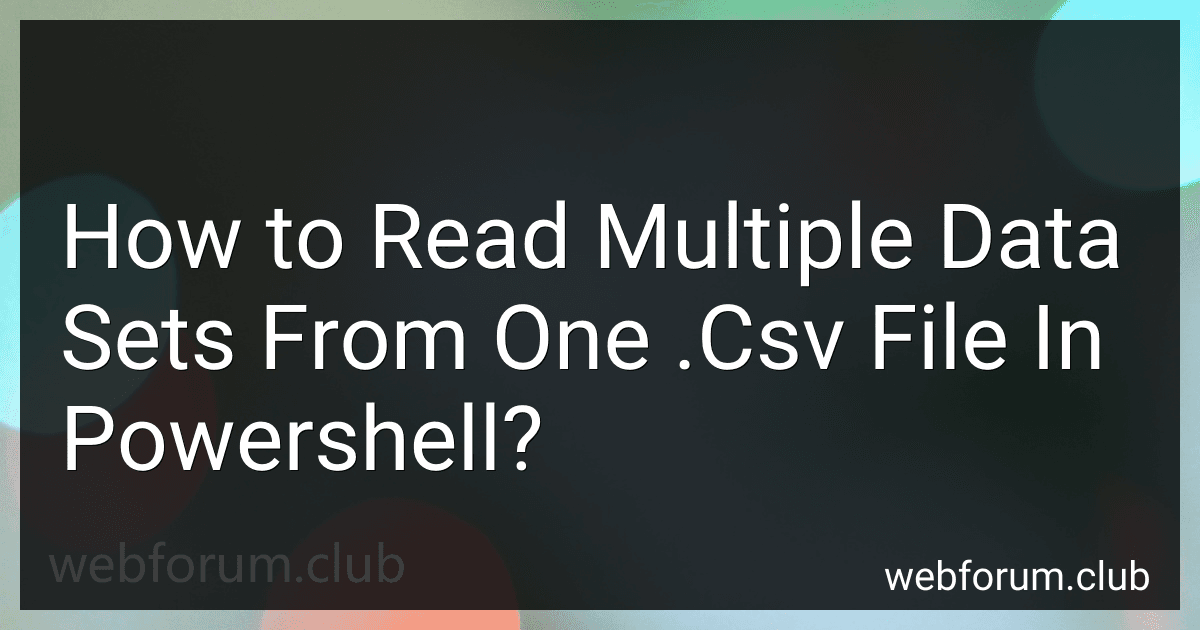In PowerShell, you can read multiple data sets from one .csv file by using the Import-Csv cmdlet to read the file's contents and then separate the data sets based on a specific criteria or delimiter. You can create custom logic to handle the data sets and manipulate them as needed. Additionally, you can use the Get-Content cmdlet to read the file line by line and separate the data sets accordingly. By leveraging these cmdlets and PowerShell scripting capabilities, you can effectively read and process multiple data sets from a single .csv file.
How to export data to a new .csv file in PowerShell?
To export data to a new .csv file in PowerShell, you can use the Export-Csv cmdlet. Here is an example of how to do this:
- Start by storing your data in a variable. For example, if you have a list of objects stored in a variable named $data, you can run the following command:
$data = Get-Process
- Next, use the Export-Csv cmdlet to export the data to a new .csv file. Specify the variable containing the data, the path where you want to save the file, and any additional parameters as needed. For example:
$data | Export-Csv -Path C:\path\to\newfile.csv -NoTypeInformation
In this example, the -NoTypeInformation parameter is used to exclude the type information from the output file. If you want to include headers in the CSV file, you can omit this parameter.
- You can now open the new .csv file in a text editor or a spreadsheet program to view the exported data.
Note: Make sure you have the necessary permissions to write to the specified file path before running the Export-Csv cmdlet.
How to filter data from a .csv file in PowerShell?
To filter data from a .csv file in PowerShell, you can use the Import-Csv cmdlet to read the contents of the .csv file and then use the Where-Object cmdlet to filter the data based on certain criteria.
Here is an example of how you can filter data from a .csv file in PowerShell:
- Import the contents of the .csv file:
$data = Import-Csv -Path "C:\path\to\your\file.csv"
- Filter the data based on a specific criteria (e.g. filtering rows where the "Name" column equals "John"):
$filteredData = $data | Where-Object { $_.Name -eq "John" }
- Display the filtered data:
$filteredData
You can also apply more complex filtering criteria using the Where-Object cmdlet. For example, filtering rows where the "Age" column is greater than 30:
$filteredData = $data | Where-Object { $_.Age -gt 30 }
By using the combination of Import-Csv and Where-Object cmdlets, you can easily filter data from a .csv file in PowerShell based on your specific requirements.
What is the purpose of delimiter in a .csv file?
The purpose of a delimiter in a .csv (Comma-Separated Values) file is to separate or delimit the different fields or columns within each row of data. By using a delimiter, such as a comma, semicolon, or tab, the data in the file can be organized and structured in a way that can be easily read and parsed by software programs. Delimiters help distinguish where one field ends and the next field begins, making it possible to import, export, and manipulate data effectively.
How to open a .csv file in PowerShell?
To open a .csv file in PowerShell, you can use the Import-Csv cmdlet. Here's how you can do it:
- Open PowerShell.
- Use the following command to import a .csv file into a variable:
$csvData = Import-Csv -Path "C:\Path\To\Your\File.csv"
Replace "C:\Path\To\Your\File.csv" with the path to your .csv file.
- You can then use the $csvData variable to access the data in the .csv file. For example, you can loop through the data and display it:
foreach ($row in $csvData) { Write-Output $row }
- To display specific columns from the .csv file, you can specify the column name in the loop. For example, to display the values in the "Name" column:
foreach ($row in $csvData) { Write-Output $row.Name }
By following these steps, you can open and work with a .csv file in PowerShell.
What is the maximum number of rows a .csv file can contain?
The maximum number of rows a .csv (comma-separated values) file can contain is typically limited by the amount of available memory and storage space on the computer or server where the file is being created or stored. There is no fixed limit on the number of rows in a .csv file, as it depends on the resources of the system handling the file. However, it is important to consider the performance and efficiency of handling large .csv files, as processing very large files can be slow and resource-intensive.
